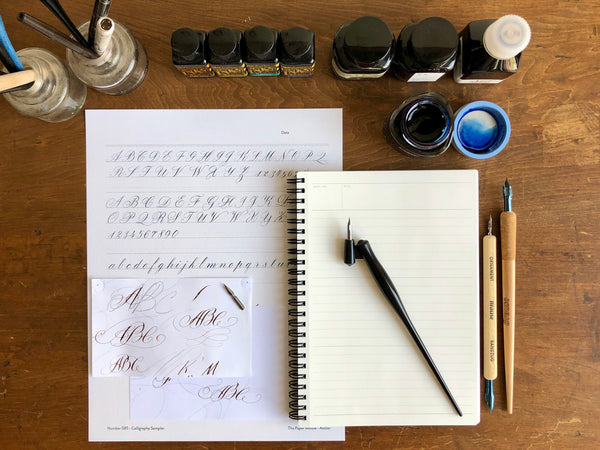Choosing Calligraphy Tools
A lot of people are becoming interested in calligraphy these days, and no wonder! It’s a beautiful art form that anyone can learn and improve at. But getting started can be a little intimidating when there are so many pens, papers and inks to choose from. Our introduction to calligraphy tools will walk you through the basics.
Brush Pen Calligraphy

Brush lettering is done with a brush or brush pen. It’s great for achieving wide strokes and bold letters, and it’s easiest for those who are just getting started.
Choosing a Pen
Choosing Paper
When choosing paper for brush lettering, you’ll want to look out for two things: feathering (when the ink spreads away from the line you write), and bleeding (when the ink soaks through to the back of the paper).
In general, smooth papers are less likely to feather and thick papers are less likely to bleed, but there are plenty of exceptions to these rules! Every pen and every ink will interact a little differently with a given paper. The best way to find a good paper for your project is to experiment.
Here are some good papers to try:
Pointed Pen Calligraphy

Pointed pen calligraphy is done with a traditional nib, pen holder, and bottled ink. With more variables, it’s a little trickier to learn, but it can produce beautiful line variation.
Choosing a Nib Holder
Pointed pen calligraphy is usually done with a dip pen, which consists of a metal nib that is dipped in ink and a shaft called a nib holder. There are a couple of things to consider when choosing a nib holder: style and compatibility with your nib.
Nib holders come in two styles - straight and oblique. Straight pens hold the nib straight up and down, while oblique pens hold the nib at an angle. The angle of the oblique holder can help the writer achieve slanted letters, so calligraphers often use oblique pens for slanted styles of calligraphy and straight pens for upright styles. However, straight pens can be used for all styles of calligraphy, and the choice is largely a matter of comfort and personal preference.
Nib holders can also have different mechanisms for holding the nib. Some holders have metal ferrules, which are metal rings with four prongs inside that will hold almost any nib size. Others have grooves in the end that will hold specific nib sizes.
Here are some nib holder options:
Choosing a Nib
To choose a nib, you’ll first want to decide on the style of calligraphy you’ll be writing. Italic and gothic scripts are written using italic nibs, which have a wide, blunt tip. Pointed pen calligraphy uses pointed nibs with flexible tips that create lines that vary in thickness. Both styles of nibs come in a variety of sizes.
Pointed nibs have two tines that draw ink down to write. These tines range from stiff to very flexible. More flexible nibs can be challenging for beginners to write with, but they will create greater line variations. Very small, fine nibs can feel scratchy to write with and will need to be dipped more frequently, but they can create very thin, elegant strokes. It’s important to experiment with different nibs to find one (or several) that works well for you.
Here are some nibs to try:
Choosing Ink
Calligraphy inks come in a rainbow of beautiful colors. Inks made specifically for calligraphy are thick and viscous, made from ground-up pigments, unlike thinner fountain pen inks, which are made from dissolved dyes. These more viscous inks will cling to a nib better, but many kinds of ink can be used with a dip pen, so it’s always good to experiment.
Calligraphy inks can be waterproof, water-resistant or water-soluble, which can be important if a project will be exposed to water. They can also interact differently with different papers, so it’s worth testing before you begin.
Here are some inks to try:
Choosing Paper
Pointed pens work best on very smooth papers. Their sharp points are less likely to catch on the paper fibers. When choosing your paper, you’ll want to look out for feathering (when the ink spreads away from the line you write) and bleeding (when the ink soaks through to the back of the paper).
In general, smooth papers are less likely to feather and thick papers are less likely to bleed, but there are plenty of exceptions to these rules! Every pen and every ink will interact a little differently with a given paper. The best way to find a good paper for your project is to experiment.
Here are some good papers to try:
Part of the fun of learning calligraphy is experimenting! It’s important to try out different materials to find the ones you like best. Check out our Calligraphy and Lettering Collection for plenty of options!



Leave a comment